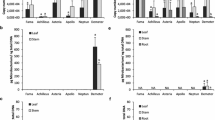Abstract
Previously, we showed that copiotrophic and oligotrophic bacteria fluctuate as moving waves along roots. These waves probably originate as a result of growth and death cycles at any location where a moving nutrient source passed. In this study, we placed sclerotia of Rhizoctonia solani AG8 along growing roots of wheat and showed that the proportions of root sections from which R. solani was isolated fluctuated with distance from the root tip. Similarly, proportions of root sections from which naturally occurring Pythium spp. were isolated fluctuated with distance from the root tip. Fourier analysis showed that these fluctuations constituted significant waves. Cross-correlation analyses demonstrated that there were negative correlations between R. solani infections and colony forming units of copiotrophic bacteria at the time of inoculation at the same locations on the root (lag = 0 cm), indicating that infection by R. solani could have been inhibited by these bacteria. There was a positive correlation between Pythium infections and copiotrophic bacteria at a lag of 6 cm along the roots. It therefore appears that Pythium infection took place shortly after the initial peak in copiotrophic bacteria following the passage of the root tip.
Similar content being viewed by others
References
Blaker NS, Hewitt JD (1987) a comparison of resistance to Phytophthora parasitica in tomato. Phytopathol 77:1113–1116
Gilligan CA, Bailey DJ (1997) Components of pathozone behaviour. New Phytol 136:343–358
Harveson RM, Rush CM (1997) Genetic variation among Fusarium oxysporum isolates from sugar beet as determined by vegetative compatibility. Plant Dis 81:85–88
Hietala AM (1997) The mode of infection of a pathogenic uninucleate Rhizoctonia sp. in conifer seedling roots. Can J Forest Res 27:471–480
Jenkins GM, Watts DG (1968) Spectral Analysis and Its Applications. Holden-Day, San Francisco
Kamula SA, Peterson CA, Mayfield CI (1994) Impact of the exodermis on infection of roots by Fusarium culmorum. Plant Soil 167:121–126
McDougall BM, Rovira AD (1970) Sites of exudation of 14C-labeled compounds from wheat roots. New Phytol 69:999–1003
Parmeter JR (1970) Rhizoctonia solani: Biology and Pathology. University of California Press, Berkeley, CA
Rovira AD (1973) Zones of exudation along plant roots and spatial distribution of microorganisms in the rhizosphere. Pestic Sei 4:361–366
Schippers B, van Vuurde JWL (1978) Studies of microbial colonization of wheat roots and the manipulation of the rhizosphere microflora. In: MW Loutit, JAR Miles (eds) Microbial Ecology. Springer-Verlag, Berlin, pp 295–298
Semenov AM, van Bruggen AHC, Zelenev VV (1999) Moving waves of bacterial populations and total organic carbon along roots of wheat. Microb Ecol 37:116–128
Shumway RH (1988) Applied Statistical Time Series Analysis. Prentice Hall, Englewood Cliffs, NJ
Singleton LL, Mihail JD, Rush CM (1992) Methods for Research on Soilborne Phytopathogenic Fungi. APS Press, St Paul, MN
Smiley RW, Uddin W (1993) Influence of soil temperature on Rhizoctonia root rot (R. solani AG-8 and R. oryzae) of winter wheat. Phytopathology 83:777–785
Van Bruggen AHC, Arneson PA (1985) A quantifiable type of inoculum of Rhizoctonia solani. Plant Dis 69:966–969
van Bruggen AHC, Semenov AM (1999) A new approach to the search for indicators of root disease suppression. Australasian Plant Pathol 28:4–10
van Bruggen AHC, Semenov AM, Zelenev VV (2000) Wavelike distributions of microbial populations along an artificial root moving through soil. Microb Ecol 40:250–259
van Vuurde JWL, Schippers B (1980) Bacterial colonization of seminal wheat roots. Soil Biol Biochem 12:559–565
Verma PR (1997) Rhizoctonia solani in cruciferous crops: A review. J Mycol Plant Pathol 27:235–250
Zelenev VV, van Bruggen AHC, Semenov AM (2000) “BAC-WAVE,” a spatial-temporal model for traveling waves of bacterial populations in response to a moving carbon source in soil. Microb Ecol 40:260–272
Zhou T, Paulitz TC (1993) In vitro and in vivo effects of Pseudomonas spp. on Pythium aphanidermatum: Zoospore behavior in exudates and on the rhizoplane of bacteria-treated cucumber roots. Phytopathology 83:872–876
Author information
Authors and Affiliations
Corresponding author
Additional information
Online publication: 20 May 2002
Rights and permissions
About this article
Cite this article
van Bruggen, A.H.C., Semenov, A.M. & Zelenev, V.V. Wavelike distributions of infections by an introduced and naturally occurring root pathogen along wheat roots. Microb Ecol 44, 30–38 (2002). https://doi.org/10.1007/BF03036871
Received:
Accepted:
Issue Date:
DOI: https://doi.org/10.1007/BF03036871




